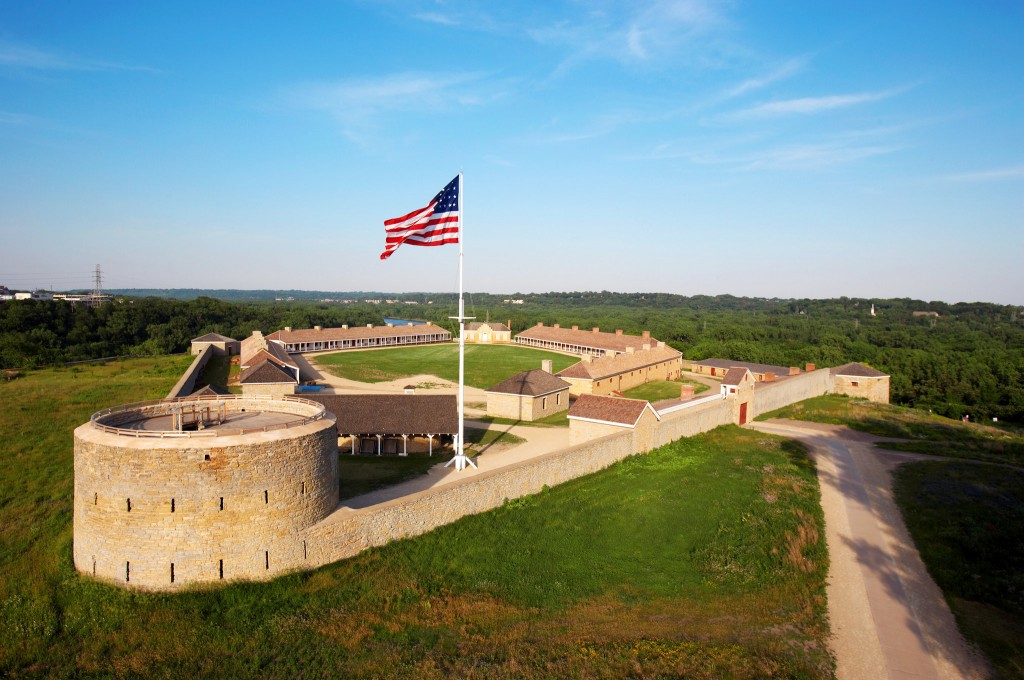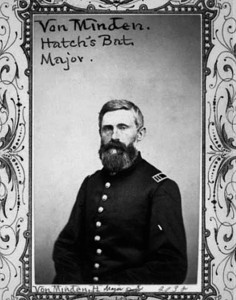By JOHN HANC
A version of this article appears in print on March 20, 2014, on page F24 of the New York edition with the headline: Making Do Without Civil War Battlefield.

Fort Snelling in St. Paul, where Minnesotans left for the Civil War, and where some returned. Credit Minnesota Historical Society
ST. PAUL — THE Civil War seems a long way from St. Paul: 1,100 miles to Manassas; 1,000 miles to Gettysburg. Even the nearest battlefields, in Missouri, are hundreds of miles away.
So if you’re the Minnesota Historical Society, how do you give the ever-popular subject of the war a local twist in your offerings — particularly during the war’s 150th anniversary, which is being marked with museum exhibits around the country on almost every conceivable aspect?
Danielle Dart, a public programs specialist with the society, which is based in St. Paul, came up with this idea: Instead of examining the brave deeds of Minnesotan soldiers during the war (already the focus of an exhibit in the spring of 2013), talk about what happened when they returned home.
Last summer, “St. Paul After the Civil War,” led by Ms. Dart, joined a lineup of existing tours, or crawls, as the society calls them. While it might not be quite as popular as the pub and food crawls that allow participants to eat and drink their way through the history of the city, the Civil War tour was a success, and it will be offered again this summer. Using a 28-passenger, air-conditioned bus, with Ms. Dart narrating, the three-hour tour, which cost $45, including lunch, was a near sellout all six times it was offered.
“We wanted to do something Civil War-related, but we knew there were no battles in St. Paul,” said Ms. Dart, 47, who has been running tours for the society since 2007. “So we thought about what happened to these men when they came home from the fighting.”
Minnesota became a state only in 1858 — three years before the war began. “This was our debut on the national stage,” Ms. Dart says. “Minnesota went big for Lincoln in 1860.” The state’s governor, Alexander Ramsey, was in Washington when Fort Sumter was fired upon. He immediately offered President Lincoln 1,000 volunteers — supposedly securing the state’s position as the first to officially offer a volunteer regiment to the Union cause, a point of pride to Minnesotans to this day.
The starting point for the tour is Fort Snelling, built in 1819 on the banks of the Mississippi and now a historic site operated by the society.
The fort is famous for its role in the Dakota War or Sioux Uprising of 1862, but it is also “the Civil War portal for Minnesota,” says Matt Cassady, a program specialist at Fort Snelling, who welcomed a reporter retracing the tour route with Ms. Dart last autumn. “For 25,000 of these men, this is where it started, and for those who survived, this is where it ended.” About 20,000 Minnesotans returned; 2,500 of them were grievously wounded, most with missing limbs.
Here on the exposed parade ground and drafty barracks of Fort Snelling is where adjustment to civilian life began. “Men would form up, get their last pay and then sit and wait for the paperwork to be drawn up,” Ms. Dart said. Once discharged, “they were on their own.”
Most would amble up Fort Road, now West Seventh Street, which the tour takes back into the city. In 1865, St. Paul was barely 25 years old, and while the economy of the river town had boomed in the war, to most Americans it might as well have been a colony on the moon.
“Before the war, Minnesota is seen as this remote, far-off place, this outpost on the edge of the American empire,” says historian Mary Lethert Wingerd of St. Cloud State University. “I think what the Civil War does do, at least for people here, is to substantiate Minnesota’s place as part of the nation.”
While such overarching themes are interesting to ponder, they are hard to build a tour around. Ms. Dart instead decided she would focus on half a dozen men whose stories she researched in the society’s archives, on websites, in census records and in old city directories.
We meet, for example, Albert Siebers, a 19-year-old teamster from Minneapolis. Seriously wounded at the Battle of Gettysburg, he returned to Minnesota for a year, then went off to become a cowboy in California. He died in 1907, at age 64, in an accident while part of a construction crew on the Roosevelt Dam in Arizona.
“Some of these men were very peripatetic, very restless after the war,” Ms. Dart says.
The tour arrives in St. Paul’s West End, one of the city’s oldest neighborhoods. Ms. Dart points out 262 Banfil Street, a blue, two-story Greek-revival house with a white front porch. This was once the home of Henning von Minden, a cavalry officer. Ms. Dart learned from her research that about 10 other German immigrants like Mr. von Minden lived within blocks of this house and volunteered for the Union army as well. As was common in other parts of the country, they very likely enlisted together in a surge of patriotism for their new country.
The West End is also where many of the veterans settled. “This would have been a middle-class neighborhood,” Ms. Dart said. “They had gas lighting not long after the war, and sidewalks.”
Suddenly the Civil War doesn’t seem quite so remote.
“There’s something compelling about saying ‘this is where that man lived,’ ” says Charles F. Bryan Jr., former president and chief executive of the Virginia Historical Society, and now a consultant who has been involved with many Civil War-related programs. “It’s a very creative way to organize a tour like this.”
Not all of the men we meet are heroes. Ms. Dart pulls up in front of 256 Goodrich Avenue.
The home is that of John Miner. A police officer after the war, he had registered for the draft in two neighboring states but never reported for duty. Other houses on the same block belonged to men who had served.
“Imagine a veteran living next door to this guy who may have run away from the draft,” she said, adding that she saw the topic as a discussion point for future tours. Ms. Dart continues her tour through the nooks and crannies of old St. Paul, ticking off the names of soldiers who lived or worked here and there or whose names adorn street signs. There are 14 streets in St. Paul named after Civil War veterans.
One never accorded that honor was Alfred Gales, an escaped slave who fell in with the 3rd Minnesota in Arkansas and became the unit’s cook. “When they mustered out, he came with them,” she said. “He met his wife and lived the rest of his life in St. Paul.”
He also changed his name legally to Alfred Miller. “I make a point of mentioning that on the tour,” Ms. Dart says. “I think it’s important that he chose a name other than his slave name once he could.”
The tour includes Oakland Cemetery, where many of the veterans are buried, and the towering Civil War memorial, the Soldiers and Sailors Monument in St. Paul, erected in 1903. The tour ends at the Minnesota Veterans’ Home, originally called the Old Soldiers Home, in Minneapolis’s Minnehaha State Park — a government-funded precursor to the Department of Veterans Affairs hospitals of today — where some of the veterans ended their days.
Summer tours include a picniclike lunch, with food from a local 1876 cookbook.
“Luckily for tourgoers,” Ms. Dart says, “late-19th-century picnic foods are remarkably similar to our own. Chicken salad and egg salad sandwiches, fresh fruit and carrot cake.” But even here, Ms. Dart seeks to make the experience as vivid as possible, regardless of the lack of a battlefield.
“Maybe next year,” she jokes, “I’ll have everyone try hardtack.”
Tours will be offered this summer. Dates and information are at www.minnesotahistorycenter.org/crawls.


